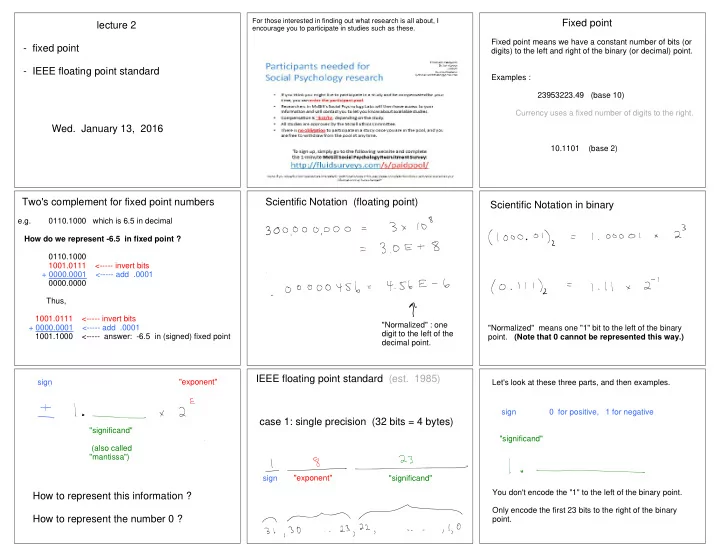

For those interested in finding out what research is all about, I Fixed point lecture 2 encourage you to participate in studies such as these. Fixed point means we have a constant number of bits (or - fixed point digits) to the left and right of the binary (or decimal) point. - IEEE floating point standard Examples : 23953223.49 (base 10) Currency uses a fixed number of digits to the right. Wed. January 13, 2016 10.1101 (base 2) Two's complement for fixed point numbers Scientific Notation (floating point) Scientific Notation in binary e.g. 0110.1000 which is 6.5 in decimal How do we represent -6.5 in fixed point ? 0110.1000 1001.0111 <----- invert bits + 0000.0001 <----- add .0001 0000.0000 Thus, 1001.0111 <----- invert bits "Normalized" : one + 0000.0001 <----- add .0001 "Normalized" means one "1" bit to the left of the binary digit to the left of the 1001.1000 <----- answer: -6.5 in (signed) fixed point (Note that 0 cannot be represented this way.) point. decimal point. IEEE floating point standard (est. 1985) sign "exponent" Let's look at these three parts, and then examples. sign 0 for positive, 1 for negative case 1: single precision (32 bits = 4 bytes) "significand" "significand" (also called "mantissa") "exponent" sign "significand" You don't encode the "1" to the left of the binary point. How to represent this information ? Only encode the first 23 bits to the right of the binary How to represent the number 0 ? point.
exponent code exponent value Q: What is the largest positive normalized number ? 00000000 reserved (explained soon) (single precision) -126 00000001 -125 00000010 - 124 00000011 : : : : This is not two's 0 01111111 complement ! 1 10000000 2 10000001 : : A: : : 127 11111110 reserved (explained soon) 11111111 unsigned exponent code = exponent value + "bias" (for 8 bits, bias is defined to be 127) Exponent code 00000000 reserved for Q: What is the smallest positive normalized number ? Dividing each power of 2 interval into 2^23 equal parts "denormalized" numbers (single precision) (same for negative real numbers). Note the power of 2 intervals themselves are equally spaced on a log scale. A: belong to includes 0 (8.75) 10 = (1.00011) 2 x 2^3 Exponent code 11111111 also reserved. Example: write 8.75 a single precision float (IEEE). First convert to binary. 23 bit significand: 00011000000000000000000 if significand is all 0's exponent value: e = 3 then value is +- infinity (depending on sign bit) exponent code = exponent value (e) + bias else value is NaN ("not a number") e.g. variable is declared but hasn't been Thus, exponent code is unsigned 3 + 127. assigned a value (130) 10 = (10000010) 2 This is the stuff you put on an exam crib sheet. (Yes, you can bring a crib sheet for the quizzes.) So, the 32 bit representation is : 0 10000010 00011000000000000000000 0 10000010 00011000000000000000000 0 x 4 1 0 c 0 0 0 0
Floating Point Addition Floating Point Addition Recall last lecture: 0.05 cannot be represented exactly. x = 0; ( ct = 0; ct < 20; ct ++) { x = 1.00100100010000010100001 * 2^2 x = 1.00100100010000010100001 * 2^2 x += 1.0 / 20; System. .println( x ); y = 1.10101000000000000101010 * 2^ {-3} y = 1.10101000000000000101010 * 2^ {-3} } x + y = ? x + y = ? 0.05 0.1 0.15 0.2 x = 1.0010010001000001010000100000 * 2^2 0.25 0.3 y = .0000110101000000000000101010 * 2^2 0.35000002 0.40000004 0.45000005 but the result x+y has more than 23 bits of significand 0.50000006 exponent code exponent value How many digits (base 10) of precision can we represent case 2: double precision (64 bits = 8 bytes) with 23 bits (base 2) ? unsigned exponent code = exponent value + bias For 11 bits, bias is defined to be 2^10 - 1 = 1023. reserved 00000000000 -1022 00000000001 -1021 00000000010 - 1020 00000000011 : : : : 0 01111111111 sign "exponent" "significand" 1 10000000000 2 10000000001 : : : : 1023 11111111110 reserved 11111111111 Example Q: What is the largest positive normalized number ? (double precision) (8.75) 10 = (1.00011) 2 x 2^3 significand (52 bits) = .0001100000000000000000000000000000.... exponent = 3, code using 11 bits: 3 + 1023 = 1026 = (10000000010) 2 double precision float (64 bits) A: 0 10000000010 00011000000000000000000000000... 0 x 4 0 2 1 8 0 0 0 0 0 000000
Approximation Errors (Java/C/...) How many digits of precision can we represent with 52 bits ? Announcements x = 0; - public web page (Course outline etc) ( ct=0; ct < 10; ct ++) { x += 1.0 / 10; - corequisite courses: System. .println( x ); } COMP 206 (official) COMP 250 (unofficial ) It is not recommended to do 250+206+273 together. 0.1 Rather, 250+206 only, or 206+273 only. 0.2 0.30000000000000004 - assignments, there will be 4 (not 3), logisim, 0.4 each should take ~10 hours (still worth total of 30%) 0.5 0.6 - waiting list issues (14 x 12 + 10 = 178 seats in room ) 0.7 52 bits covers about the same "range" as 16 digits. 0.7999999999999999 0.8999999999999999 That is why the print out on the previous slide had up to - quiz 1: may have to sit on stairs and use a book :/ 0.9999999999999999 (about) 16 digits to the right of the decimal point. (only 15 min)
Recommend
More recommend